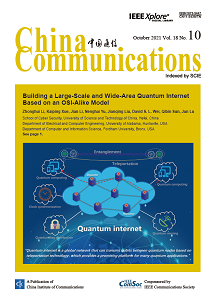Intelligent edge network routing architecture with blockchain for the IoT
IF 3.1
3区 计算机科学
Q2 TELECOMMUNICATIONS
引用次数: 2
Abstract
The demand for the Internet of Everything has slowed down network routing efficiency. Traditional routing policies rely on manual configuration, which has limitations and adversely affects network performance. In this paper, we propose an Internet of Things (IoT) Intelligent Edge Network Routing (ENIR) architecture. ENIR uses deep reinforcement learning (DRL) to simulate human learning of empirical knowledge and an intelligent routing closed-loop control mechanism for real-time interaction with the network environment. According to the network demand and environmental conditions, the method can dynamically adjust network resources and perform intelligent routing optimization. It uses blockchain technology to share network knowledge and global optimization of network routing. The intelligent routing method uses the deep deterministic policy gradient (DDPG) algorithm. Our simulation results show that ENIR provides significantly better link utilization and transmission delay performance than various routing methods (e.g., open shortest path first, routing based on Q-learning and DRL-based control framework for traffic engineering).面向物联网的区块链智能边缘网络路由架构
万物互联的需求降低了网络路由的效率。传统的路由策略依赖于手工配置,存在一定的局限性,且对网络性能影响较大。本文提出了一种物联网(IoT)智能边缘网络路由(ENIR)架构。ENIR采用深度强化学习(deep reinforcement learning, DRL)模拟人类对经验知识的学习,并采用智能路由闭环控制机制与网络环境进行实时交互。该方法可以根据网络需求和环境条件,动态调整网络资源,进行智能路由优化。利用区块链技术实现网络知识共享和网络路由全局优化。智能路由方法采用深度确定性策略梯度(DDPG)算法。仿真结果表明,ENIR的链路利用率和传输延迟性能明显优于各种路由方法(如开放最短路径优先、基于q -学习的路由和基于drl的流量工程控制框架)。
本文章由计算机程序翻译,如有差异,请以英文原文为准。
求助全文
约1分钟内获得全文
求助全文
来源期刊

China Communications
工程技术-电信学
CiteScore
8.00
自引率
12.20%
发文量
2868
审稿时长
8.6 months
期刊介绍:
China Communications (ISSN 1673-5447) is an English-language monthly journal cosponsored by the China Institute of Communications (CIC) and IEEE Communications Society (IEEE ComSoc). It is aimed at readers in industry, universities, research and development organizations, and government agencies in the field of Information and Communications Technologies (ICTs) worldwide.
The journal's main objective is to promote academic exchange in the ICTs sector and publish high-quality papers to contribute to the global ICTs industry. It provides instant access to the latest articles and papers, presenting leading-edge research achievements, tutorial overviews, and descriptions of significant practical applications of technology.
China Communications has been indexed in SCIE (Science Citation Index-Expanded) since January 2007. Additionally, all articles have been available in the IEEE Xplore digital library since January 2013.
 求助内容:
求助内容: 应助结果提醒方式:
应助结果提醒方式:


